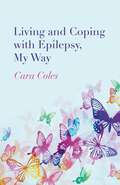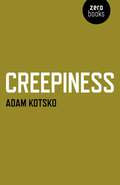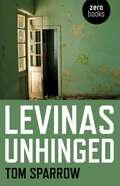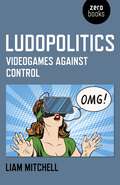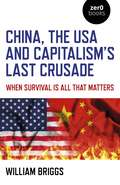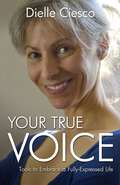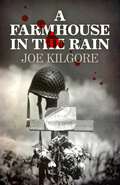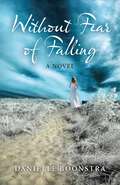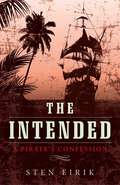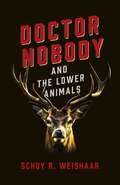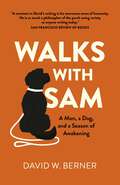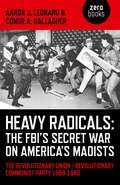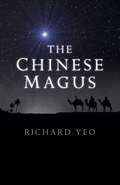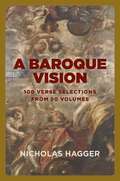- Table View
- List View
Living and Coping with Epilepsy, My Way
by Cara ColesYou really can have anything you want out of life, no matter what. Living and Coping with Epilepsy, My Way is about the author's journey living and dealing with epilepsy, finding the law of attraction, and how her life has changed since then.
Creepiness
by Adam KotskoA specter is haunting contemporary television—the specter of creepiness. In our everyday lives, we try to avoid creepiness at every cost, shunning creepy people and recoiling in horror at the idea that we ourselves might be creeps. And yet when we sit down to watch TV, we are increasingly entranced by creepy characters. In this follow-up to Awkwardness and Why We Love Sociopaths, Adam Kotsko tries to account for the strange fascination of creepiness. In addition to surveying a wide range of contemporary examples—from Peep Show to Girls, from Orange is the New Black to Breaking Bad—Kotsko mines the television of his 90s childhood, marveling at the creepiness that seemed to be hiding in plain sight in shows like Full House and Family Matters. Using Freud as his guide through the treacherous territory of creepiness, Kotsko argues that we are fascinated by the creepy because in our own ways, we are all creeps.
Capitalist Realism: Is there no alternative?
by Mark FisherAfter 1989, capitalism has successfully presented itself as the only realistic political-economic system - a situation that the bank crisis of 2008, far from ending, actually compounded. The book analyses the development and principal features of this capitalist realism as a lived ideological framework. Using examples from politics, films, fiction, work and education, it argues that capitalist realism colours all areas of contemporary experience. But it will also show that, because of a number of inconsistencies and glitches internal to the capitalist reality program capitalism in fact is anything but realistic.
Levinas Unhinged
by Tom SparrowThrough six heterodox essays this book extracts a materialist account of subjectivity and aesthetics from the philosophy of Emmanuel Levinas. More than a work of academic commentary that would leave many of Levinas s pious commentators aghast, Sparrow exhibits an aspect of Levinas which is darker, yet no less fundamental, than his ethical and theological guises. This darkened Levinas provides answers to problems in aesthetics, speculative philosophy, ecology, ethics, and philosophy of race, problems which not only trouble scholars, but which haunt anyone who insists that the material of existence is the beginning and end of existence itself.
Methods Devour Themselves: A Conversation
by J. Moufawad-Paul Benjanun SriduangkaewMethods Devour Themselves is a dialogue between fiction and non-fiction. Inspired by Quentin Meillassoux's Science Fiction and Extro-Science Fiction that was paired with an Isaac Asimov short story, this book examines the ways in which stories can provoke philosophical interventions and philosophical essays can provoke stories. Alternating between Benjanun Sriduangkaew's fiction and J. Moufawad-Paul's non-fiction, Methods Devour Themselves is an interstitial project that brings fiction and essay into a unique, avant-garde whole.
That Existential Leap: A Crime Story
by Dolan CummingsPart bildungsroman and part psychological thriller, That Existential Leap is a novel of ideas about the struggle for self-realisation and belonging in the postmodern West. Claudette Dasgupta is a thoughtful but unremarkable American teenager unenthusiastic about the prospect of college and a conventional life. When she meets the heroically mysterious Siegfried at the New York Public Library, she barely hesitates to throw in her lot with him, but soon finds an unscripted life is scarier, and harder, than she could have imagined. Meanwhile, across the Atlantic in Siegfried&’s home town Glasgow, unconventional police detective Alexander investigates his disappearance. Alexander is soon caught up in still more unworldly affairs as his work spirals out of control and his personal life unravels. As the two stories wrap around one another, encompassing the worlds of crime and gangsterism, the law and police work, music and the supernatural, Dolan Cummings' novel explores the terrifying uncertainty at the core of all human relationships.
A Floating Phrase
by Trent PortigalA Floating Phrase explores the nature of art, fear and snow puddles through the experiences of Cesarine, a stop-motion animator caught up in the intrigues of international diplomacy in 1970s continental Europe. At that time, national delegations for international conferences on European issues, such as those leading up to the Helsinki Accords, typically included defectors from the other side of the Iron Curtain. This led to scientists and artists with little experience in diplomacy being involved in high-level politics.
Leaving the City: Health and Happiness in the Other America
by Jeffrey TiptonLeaving the City is a visionary book about health and happiness in the &‘other' America - the places outside of the intense urban centers like NYC and LA. The urban world is known for its harried pace, mutual alienation and distance from the rhythms of nature and of human nature. He focuses not merely on contagion, pollutants, violence and innumerable other sources - both natural and human - of illness, disability and premature death that one finds in urban America, but also addresses the inherent unhappiness and threats to mental health that life in the urban world typically brings.
Land of Hunger: A Collection of Short Stories; Alternatively One Long One
by Wayne HollowayLand of Hunger is a collection of short stories, that interconnect, loop and return upon each other despite their seemingly disparate subject matter. Fragments that resonate across time and place, from the Ukraine during the Russian Civil War, to the miners' strike, to the world of animal rights protestors. The stories are all about the collection of fictions that make up a writer. A fantasy of who the author is, where he comes from; the story of a fragile, shifting identity built on facts, yet obscuring them. In doing this, Wayne Holloway embodies our deep hunger for the stories of who and why we are.
Ludopolitics: Videogames against Control
by Liam MitchellWhat can videogames tell us about the politics of contemporary technoculture, and how are designers and players responding to its impositions? To what extent do the technical features of videogames index our assumptions about what exists and what is denied that status? And how can we use games to identify and shift those assumptions without ever putting down the controller? "Ludopolitics" responds to these questions with a critique of one of the defining features of modern technology: the fantasy of control. Videogames promise players the opportunity to map and master worlds, offering closed systems that are perfect in principle if not in practice. In their numerical, rule-bound, and goal-oriented form, they express assumptions about both the technological world and the world as such. More importantly, they can help us identify these assumptions and challenge them. Games like "Spec Ops: The Line," "Braid," "Undertale," and "Bastion," as well as play practices like speedrunning, theorycrafting, and myth-making provide an aesthetic means of mounting a political critique of the pursuit and valorization of technological control.
China, the USA and Capitalism's Last Crusade: When Survival is All That Matters
by William BriggsAs the sun rises on China and sets on America, the world holds its breath. China, the USA and Capitalism's Last Crusade looks at the rise of China and the decline of the USA but from a different angle. William Briggs argues that this struggle for economic supremacy is being played out against a much bigger backdrop; the decline of the economic structure of capitalism. In this sense, the decline of the USA is portrayed as that larger economic decline in microcosm. Briggs examines the relationship between state and capital, of how capitalism came to dominate the world, and of the historical, political and economic rise of both the USA and China. He shows that the struggle between the two nations has little to do with cultural, historical, demographic, political or ideological differences, but with what they have in common. Despite the portrayal of China as being &‘socialist' it functions as a capitalist economy in the globalised capitalist world. While its journey to capitalism may have differed, the end point is the same and this is why there is such animosity, such conflict, such acrimony between the two states.
Your True Voice: Tools to Embrace a Fully-Expressed Life
by Dielle CiescoThis book is alive. It senses your presence. It is meant to be like an apprenticeship with a wise teacher...the teacher being you. There is power on every page should you choose to open to receive it. In fact, this book is reading you just as you are reading it. It's in partnership with Life, and the three of you, whether you realize it or not, are colluding to give you exactly what you need. It will arrive, whether or not you follow through on the exercises. Your intent is enough to bring it to you. Will you be aware when it arrives or will the moment pass unrecognized?" A treasure trove of poetic activations and sound wisdom based on The Unknown Mother: A Magical Walk with the Goddess of Sound, YOUR TRUE VOICE is a stand-alone or companion text offering detailed practices that encourage your enchanted journey through the 10 Gates of Sound...The Vocal Channel, Breath, Letters, Words, Storytelling, Listening, Vibration, Vocal Toning, True Voice, and Rainbow Light, and beyond. Included are quotes from the original text, explanations, anecdotes, journal prompts, and the all new Transformational Voicework processes…powerful tools to help you recover your authenticity, creativity, and truth for a fully-expressed Self!
A Farmhouse in the Rain
by Joe KilgoreA Farmhouse in the Rain is a novel of war and peace, crime and punishment, love and loss, and eventually hope. It's a saga of three American soldiers and the women they love - before, during, and after World War II. During the war, the three are given shelter by a French woman. The next morning she is found dead and the trio realize they were the only ones in the house. While the three survive the war, the questions remain: Who will survive the peace? Who will unite with the love they left behind? And who will be unmasked as the murderer on that fateful night at A Farmhouse in the Rain.
Without Fear of Falling: A Novel
by Danielle BoonstraTwenty-two-year-old Ellie Stewart would much rather forget that she can see into the past lives of those she meets, but when she crosses paths with Declan O Shea, an attractive yet troubled artist, flashes of 18th-century Britain begin to plague her mind and push Ellie to uncover the mystical connection that she and Declan share. Enlisting the help of her childhood mentor and psychic, Mrs. Dawes, Ellie is brought back to a time when she was Louisa, saintly and beautiful, and Declan was William, handsome and driven by a shameful past. Will Ellie be able to face the truth of all that happened so long ago? And if she can, will Declan believe her? Weaving between present-day Tobermory, Canada and 18th-century Tobermory, Scotland is a tale of love, loss and forgiveness across time.
The Kybalion: The Three Initiates
by Lucas Fernando Sosa Alberto O. AslaAs a modern version of one of the greatest classics of esoteric literature, this book is rich in symbolism with a narrative and visual manifestation that will mesmerise the reader. Simultaneously simple and complex, this work will help open wide the door of knowledge. Each chapter is accompanied by an image whose graphic, enigmatic and archetypal form artistically represents the infinite wisdom that the work possesses. These optical illusions give the reader a better visualization of the universe and how immensely infinite it is, in addition to how imperceptible it may be in the eyes of the human being...
The Intended
by Sten EirikA young, up-and-coming Swedish officer is suddenly and traumatically forced into the role of victim, as his newly wedded bride is defiled and murdered by pirates. His mode of survival is to become someone new, who works hard to suppress the memory of his own victimhood. He insinuates himself with the perpetrators and becomes captain of their ship. Only years later, when a new woman is able to touch his heart, he re-discovers the seat of his buried pain and turns against his own brood to avenge his slaughtered bride and his own slaughtered innocence.
Drone and Apocalypse: An Exhibit Catalog for the End of the World
by Joanna DemersDrone and Apocalypse is an exhibit catalog for a retrospective of twenty-first-century art. Its narrator, Cynthia Wey, is a failed artist convinced that apocalypse is imminent. She writes critical essays delineating apocalyptic tendencies in drone music and contemporary art. Interspersed amid these essays are &“speculative artworks&”, Wey&’s term for descriptions of artworks she never constructs that center around the extinction of humanity. Wey&’s favorite musicians are drone artists like William Basinski, Celer, Thomas Köner, Les Rallizes Dénudés, and Éliane Radigue, and her essays relate their works to moments of ineffability in Herodotus, Aristotle, Plato, Pliny the Elder, Isidore of Seville, Robert Burton, Hegel, and Dostoyevsky. Well after Wey&’s demise, the apocalypse never arrives, but Wey&’s journal is discovered. Curators fascinated with twenty-first-century culture use her writings as the basis for their exhibit &“Commentaries on the Apocalypse&”, which realizes Wey&’s speculative artworks as photographs, collages, and sound/video installations.
Doctor Nobody and the Lower Animals
by Schuy R. WeishaarHopkins Carver, a detective in a small town in Illinois, is caught between The Society, a white supremacist group headed by a disgraced pastor, and ARAFO, a violent anti-fascist resistance movement. The situation becomes critical when a black girl is found dead in an abandoned farmhouse. Is she just another victim in a local suicide epidemic, or is The Society involved? The town is on edge, and Carver may be losing his mind to Grief Machine, a new drug that has hit the town. Reality and memory blend with history and hallucination, and the lines between man and animal, between one's own mind and the rest of the world, are blurred as the war reaches a fever pitch.
Walks With Sam: A Man, a Dog, and a Season of Awakening
by David W. BernerA man, his dog, and a long walk can lead to unexpected discoveries. In the tradition of many literary walkers, David W. Berner sets out on foot hoping to reexamine his life, look back and forward, and most importantly, through the help of his young dog, Sam, try to find harmony in new beginnings and the uncertainties of the present. In a series of chapters, each dedicated to one walk during a summer of hiking, the author finds that it is his beloved pet that allows him to awaken to a new spirit of mindfulness, finding beauty, wonder, and comfort in the ordinary, and to see a life, a neighborhood, and even a country with brand new eyes. 'With gentle humor and brilliant musings, both past and present, Walks With Sam has the charm and the innate truthfulness that some find in a work of art, a daily quest tinged with wonder and mystery with each forward step.' L.B.Johnson, author of The Book of Barkley.
Advancing Conversations: Aubrey De Grey - Advocate For An Indefinite Human Lifespan
by Douglas Lain Aubrey de GreyAdvancing Conversations is a line of interview books documenting conversations with artists, authors, philosophers, economists, scientists, and activists whose works are aimed at the future and at progress. The biogerontologist Aubrey de Grey, as the world's pre-eminent longevity advocate, is nothing if not future oriented. De Grey is the founder of the SENS Research Foundation, an organization developing medical interventions to repair the damage the body does to itself over time. Stated more directly, Aubrey de Grey and his organization aim to defeat aging. In 2005 a panel of scientists and doctors from MIT, Brigham and Women's Hospital in Boston, Microsoft, and the Venter Institute participated in a contest to judge whether de Grey's "Strategies for Engineered Negligible Senescence" were worthy of debate and verification or whether these ideas were wrong on their face. The panel found that de Grey's proposals for intervening in the aging process, while speculative, often "ran parallel to existing research" and were not "demonstrably wrong."
Miracles Are Made of This
by Julia HeywoodMiracles Are Made of This is a contemporary story about wisdom; the one and only ingredient which enables miracles to happen. The central character is female and she has found wisdom. It was there all along, in the one place she had never previously looked - within her. Her success was achieved through a training programme designed for her by wise people. Miracles Are Made of This charts the next phase in her never ending story, which requires her to devise training programmes for others, so that they, too, can connect with their own innate wisdom. The tasks and exercises she sets for the people she meets are all in the context of their day to day lives, adhering to the fundamental principle that in the midst of the apparently ordinary the extraordinary will be found.
Heavy Radicals - The FBI's Secret War on America's Maoists: The Revolutionary Union / Revolutionary Communist Party 1968-1980
by Aaron J. Leonard Conor A. GallagherNEW EDITION OUT OCTOBER 28TH, 2022Heavy Radicals: The FBI's Secret War on America's Maoists is a history of the Revolutionary Union/Revolutionary Communist Party — the largest Maoist organization to arise in the US — from its origins in the explosive year of 1968, its expansion into a national organization in the early seventies, its extension into major industry throughout early part of that decade, the devastating schism in the aftermath of the death of Mao Tse-tung, and its ultimate decline as the 1970s turned into the 1980s. From its beginnings the grouping was the focus of J. Edgar Hoover and other top FBI officials for an unrelenting array of operations: Informant penetration, setting organizations against each other, setting up phony communist collectives for infiltration and disruption, planting of phone taps and microphones in apartments, break-ins to steal membership lists, the use of FBI &‘friendly journalists&’ such as Victor Riesel and Ed Montgomery to undermine the group, and much more. It is the story of a sizable section of the radicalized youth of whose radicalism did not disappear at the end of the sixties, and of the FBI&’s largest — and up to now, untold — campaign against it.
Purgatory Press / After the End
by John CulbertVanished poets, overlooked artists, hapless visionaries: The Purgatory Press opens a tantalizing window on a publisher's catalogue of improbable books. Dark, comical, and startlingly inventive, After the End is a dazzling display of postmodern storytelling. These short fictions showcase the many talents of an emerging author.
The Chinese Magus
by Richard YeoXiang Li is a cultured, rational Chinese Mandarin, Governor of Xinjiang Province. He sees a sign in the skies and falls under a compulsion to travel to the west in the depth of winter. Nothing is clear but that he must hurry. His journey takes him through the snow-choked passes of the Tian Shan mountains and the searing heat of the Syrian Desert, through ambush by evil tribesmen and the deadly court of King Herod, while ahead of him rises a light in the night sky...
A Baroque Vision: 100 verse selections from 50 volumes
by Nicholas HaggerBetween 1979 and 1982 Nicholas Hagger wrote three letters to the eminent literary critic Christopher Ricks about his poetic identity, and Ricks agreed with his final view that his verse blends the Romantic and Classical traditions within the Baroque tradition. In 1979 and again in 1982 Ricks asked him to select 30 poems. Forty years later A Baroque Vision presents a selection that shows his Baroque roots. Part One presents 30 poems written before 1979, and Part Two adds 70 verse selections written between 1979 and 2019. A Baroque Vision presents 100 verse selections drawn from 50 volumes of his poems, verse plays and masques. The Baroque style, which can be found in all European countries, combines the spiritual and the sensual, and features movement, transformation, the Mystic Way, the mysterious Light, the transcending of death, the divine soul and Heaven, as illustrated in Rubens' The Apotheosis of James I (shown on the front cover); and blends the Romantic and Classical traditions. In his Preface Hagger shows very clearly that his Baroque vision was behind, and grew into, his Universalism, his philosophy and worldview of the unity of the universe whose development can be traced in his Selected Letters and Collected Prefaces, and in the companion volume to this work The Essentials of Universalism (all published by O-Books). These 100 verse selections confirm that his Baroque vision is inspired by the 17th century (by the Metaphysical poets, Milton and Dryden), but also by the 18th and 19th centuries (by Pope, Wordsworth and Tennyson).
